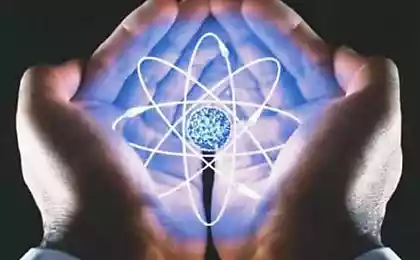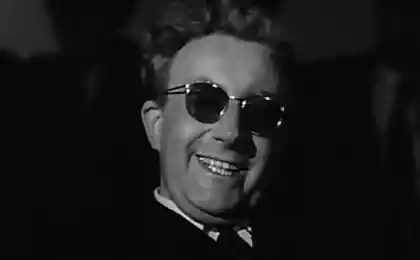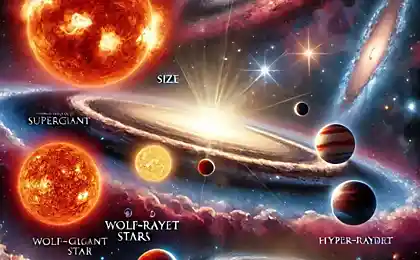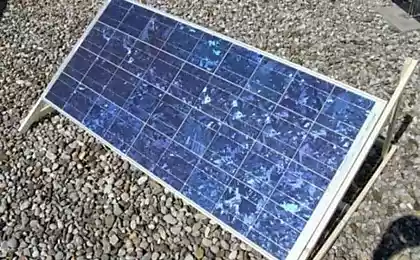1854
Review article about nucleosynthesis in stars, stellar evolution and supernovae
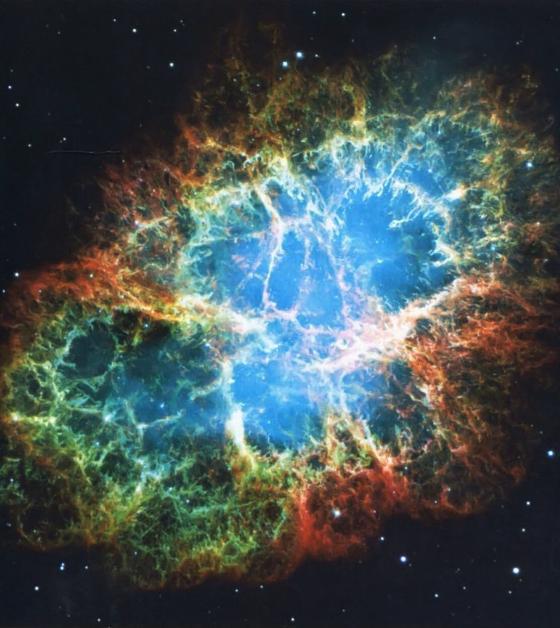
a supernova remnant in the constellation of the Crab, broke out in 1054 AD and recorded by Chinese astronomers. Sup>
All variety of chemical elements existing in nature we must stars. Indeed, in the early days of the universe primary fusion gave universe only hydrogen and helium.
After hundreds of thousands of years, lit the first stars, which began in the synthesis of nuclei of heavier elements. After all, what is a star? Star - a balance between the energy released during nucleosynthesis in its core, and the gravitational force, compressive star. Eventually, gravity always wins - it's only a matter of time.
How does vnutrizvёzdnaya alchemy? I>
The primary resource for fusion are hydrogen nuclei, of which more than 90% and consist stars. (Composition of modern stars - 93% 7% hydrogen, helium 1%, all other items)
As a result of nuclear fusion of four protons eventually form a helium nucleus, with the release of a number of different elementary particles. In the final state the total mass of the produced particles smaller than that of the original four protons, which means that in the course of reaction produces free energy. Because of this, the inner core of the new-born star quickly warmed up to extremely high temperatures, and it begins to spill excess energy towards it less hot surface. At the same time, and increases the pressure in the center of the star (Mendeleyev-Clapeyron equation). Thus, the "burning" of hydrogen in the process of thermonuclear reaction, the star does not give the forces of gravity to compress itself to a superdense state, opposing gravitational collapse continuously renewable internal thermal pressure, resulting in an sustainable energy balance. This period of life called main sequence stars (in the Hertzsprung-Russell) and is the longest. In particular, the Sun is in the active stage of the combustion of hydrogen in the process of nucleosynthesis active for about 5 billion years, and stocks of hydrogen in the core for its continuation to our luminary should be enough for another 5, 5 billion years.
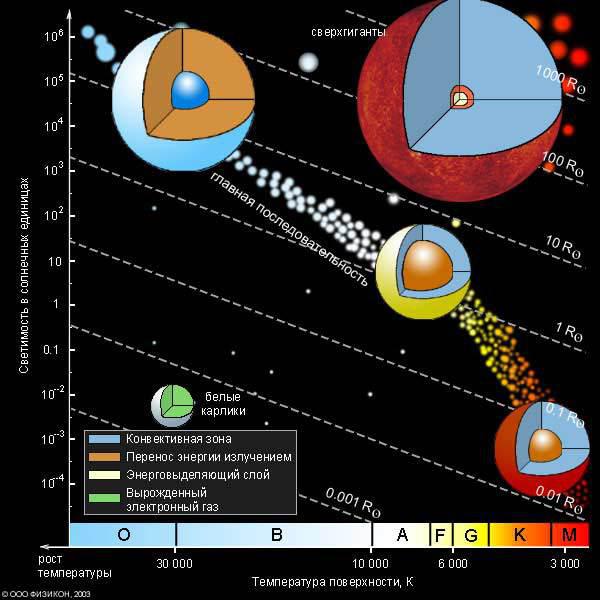
Hertzsprung-Russell sup>
I must say that the defining property of a star is, of course, its mass. Most of the stars in the range from 0 1 to 100 suns. We, as patriots, of course, measure the mass of stars in the solar mass.
The main phases of the stars differ in their properties and duration depending on the weight, but the beginning of the end for all the same.
As the depletion of hydrogen inside the star power of gravitational contraction, patiently awaiting the hour from the inception of the lights begin to prevail - and under the influence of their star begins to shrink and thicken. This process leads to a twofold effect: the temperature in the layers surrounding the core, the star rises to a level at which it contained hydrogen reacts fusion to form helium. At the same time, the temperature in the core, which consists now of almost one helium increases so that the very helium - a kind of "ashes" decaying primary reaction nucleosynthesis - entering a new fusion reaction: three helium nuclei form one carbon nucleus. This process is a secondary reaction of thermonuclear fusion fuel for which products are the primary reaction - one of the key moments of the life cycle of stars.
In secondary combustion of helium in the core of the star stands out so much energy that the star begins to literally swell. In particular, the shell of the sun at this stage will expand beyond the orbit of Venus. Wherein the total radiation energy of the star remains at approximately the same level as during the main phase of its life, but because this energy is radiated through the now much larger surface area, the outer layer of the star cools to red portion of the spectrum. The star becomes a red giant.
For the stars of the Sun class after depletion of fuel supply secondary reaction nucleosynthesis, again comes the stage of gravitational collapse - this time final. The temperature inside the core is no longer able to rise to the level necessary to start another thermonuclear fusion reaction. Therefore, the star contracts until such time as the forces of gravitational attraction will not be balanced by the pressure of the degenerate electron gas. Electrons, up to this point had not played a prominent role in the evolution of stars, at a certain stage of compression due to high pressure and temperature inside the nucleus of almost all leave their nuclear orbitals. Being in such a high-energy state, they have themselves resist gravitational contraction. Star condition is stabilized, and it turns into a white dwarf, which will radiate into space residual heat until cool completely.
Stars more massive than the sun, waiting for a much more spectacular end. After combustion of helium their mass during compression is sufficient to heat the core and shell to the temperatures required to run the following reactions of nucleosynthesis - carbon, then silicon, magnesium - and so on, with the growth of nuclear masses. Thus, at the beginning of each new reaction in the core continues its previous envelope. Thus, the star begins to resemble an onion with different fusion reactions in certain layers. In fact, all chemical elements up to iron, of which the universe was formed as a result of nucleosynthesis in the depths of dying stars of this type. But iron - is the limit; it can not serve as fuel for nuclear fusion reactions or decay at any temperature and pressure, as for its collapse, and to add to it additional nucleons needed influx of external energy. As a result of a massive star gradually accumulates inside the iron core, incapable serve as fuel for any further nuclear reactions.
Once the temperature and pressure inside the core reached a certain level, the electrons begin to be pushed into protons iron nuclei, whereby the neutrons produced. And in a very short period of time - some theorists believe that this takes a matter of seconds, the electrons are literally dissolve in the proton nuclei of iron, and all the material core of the star turns into a continuous bundle of neutrons and begins to shrink rapidly in the gravitational collapse because accuse him of a degenerate electron pressure gas falls to zero. The outer shell of the star, from under which is stamped every prop, falls to the center. Collision energy collapsed outer shell with a neutron nucleus is so high that it is with great speed bounce and scatter in all directions from the nucleus - and the star explodes in a blinding flash of a supernova. In a matter of seconds in a supernova explosion can be released into space more energy than they emit at the same time, all the stars of the galaxy together.
After the supernova shell expansion and the stars of a mass of about 10-30 solar masses ongoing gravitational collapse leads to the formation of a neutron star, a substance which is compressed until until begins to make itself felt the pressure of degenerate neutrons - in other words, now neutrons (like Moreover, as previously did electrons) begin to resist further compression.
Finally, if the mass of the stellar core is more than 30 solar masses, nothing can stop its further gravitational collapse, and as a result of a supernova a black hole.
Why supernovae are so important? I>
Recently, due to the observational data confirmed the hypothesis that fusion occurs also in the very moment of the supernova explosion - the shock wave passes through all the layers of the star, for a moment, significantly increasing the pressure, and starts a short-term synthesis of the heaviest elements of the periodic table.
Furthermore, supernovae are the main distributors of elements in the universe, throwing them to the many hundreds of light years away from their place of birth. And the radiation pressure of the surrounding gas and dust clouds starts the process of birth of new stars.
How do we learn about the chemical composition of objects such as stars? I>
The fact that the atoms of each element are strictly defined resonant frequency, whereby at these frequencies they emit or absorb light. This leads to the fact that in spectroscopy spectra show line (dark or light) in certain areas, specific to each substance. The intensity of the lines depends on the number of substances and its condition.
Optical spectroscopy originated in 1802, when they were discovered dark lines in the solar spectrum. These lines are re-discovered and described in 1814 by Fraunhofer. In the 60s of the XIX century Kirchhoff gave almost correct interpretation of these lines, assuming that this absorption lines due to the presence in the solar atmosphere of different gases, and that is associated with each specific gas line.
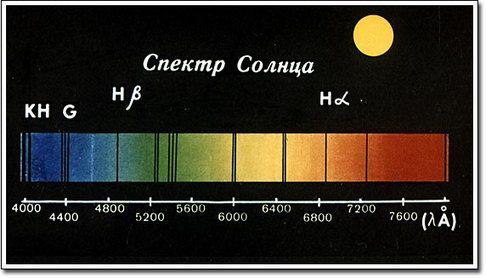
Targeted scientific spectroscopy began in 1853 when compared the Angstrom emission line gases with different chemical elements - so was born a new method for obtaining information on the composition of substances - spectral analysis. Now it is one of the most powerful tools of modern science. This sensitive method is widely used in analytical chemistry, astrophysics, metallurgy, engineering, geological exploration, archeology and other branches of science.
Source: geektimes.ru/post/242474/
Established contactless transmission on magnets, which operates at room temperature
Simple Science - digest experiments # 38

